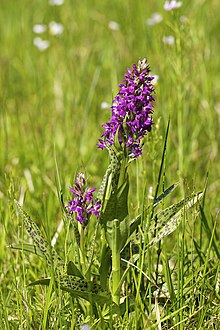Dactylorhiza majalis
| Dactylorhiza majalis | |
|---|---|
 |
|
| Scientific classification | |
| Kingdom: | Plantae |
| (unranked): | Angiosperms |
| (unranked): | Monocots |
| Order: | Asparagales |
| Family: | Orchidaceae |
| Tribe: | Orchideae |
| Genus: | Dactylorhiza |
| Species: | D. majalis |
| Binomial name | |
|
Dactylorhiza majalis (Rchb.) P.F. Hunt & Summerh. |
|
Dactylorhiza majalis (western marsh orchid, broad-leaved marsh orchid, fan orchid, common marsh orchid, or Irish marsh orchid) is a terrestrial Eurasian orchid.
The western marsh orchid grows mainly in nitrogen-poor marsh areas that consist of several plant communities. More rarely, it is found in fens. Its flowering period begins at lower elevations as early as the beginning of May and ends in higher elevations at the end of July. The lowest blossoms usually open even before the stem has reached its full height.
The western marsh orchid is usually 15 to 40 cm (6 to 15.5 in) tall, though some specimens may reach 60 cm (2.0 ft). Three to eight dark spotted leaves are distributed on the stem, which is hollow. The lower leaves are ovate to lanceolate and 6 to 18 cm (2.5 to 7 in) long and 1.5 to 3.5 cm (⅝ to 1⅜ in) wide. The upper leaves are increasingly smaller and more lanceolate. The bracts are about as long as the blossom and cover it before it blooms. The densely flowered inflorescence, which is 4 to 15 cm (1.5 to 6 in) long, is at first conical, but distinctly cylindrical when in full blossom. The seven to forty blossoms are colored purplish red, rarely light pink or white. The lateral tepals of the external circle of the perianth stand obliquely or vertically upright. They are 7 to 12 mm (¼ to ½ in) long and 2.5 to 5 mm (⅛ to 3⁄16 in) wide. The middle tepal is smaller and forms a "helmet" together with the two lateral tepals of the internal circle. These are 6 to 11 mm (¼ to 7⁄16 in) long. The trilobate lip is 5 to 10 mm (3⁄16 to ⅜ in) long and 7 to 14 mm (¼ to 9⁄16 in) wide. The shape and pattern of the lips are variable. In the lighter central area of the lip the markings are made up of lines, streaks, or dots. The spur is bent slightly downwards and is not quite as long as the ovary. The tuber has a palmate division and an irregular shape.
The western marsh orchid has a karyotype of two sets of forty chromosomes. The seed of this orchid contains no endosperm for the embryo. Therefore, germination can take place only by means of infection with a root fungus (mycorrhiza).
...
Wikipedia
